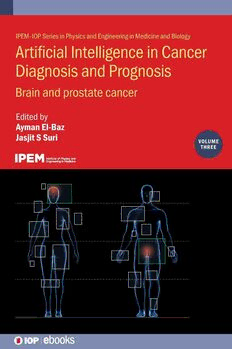
Artificial Intelligence in Cancer Diagnosis and Prognosis, Volume 3: Brain and prostate cancer PDF
Preview Artificial Intelligence in Cancer Diagnosis and Prognosis, Volume 3: Brain and prostate cancer
Artificial Intelligence in Cancer Diagnosis and Prognosis, Volume 3 Brain and prostate cancer Online at: https://doi.org/10.1088/978-0-7503-3603-1 IPEM–IOP Series in Physics and Engineering in Medicine and Biology Editorial Advisory Board Members Frank Verhaegen Kwan Hoong Ng Maastro Clinic, The Netherlands University of Malaya, Malaysia Carmel Caruana John Hossack University of Malta, Malta University of Virginia, USA Penelope Allisy-Roberts Tingting Zhu formerly of BIPM, Sèvres, France University of Oxford, UK Rory Cooper Dennis Schaart University of Pittsburgh, PA, USA TU Delft, The Netherlands Alicia El Haj Indra J Das University of Birmingham, UK NorthwesternUniversityFeinbergSchool of Medicine, USA About the Series TheSeriesinPhysicsandEngineeringinMedicineandBiologywillallowtheInstitute of Physics and Engineering in Medicine (IPEM) to enhance its mission to ‘advance physics and engineering applied to medicine and biology for the public good’. It focuses on key areas, including, but not limited to: (cid:129) clinical engineering (cid:129) diagnostic radiology (cid:129) informatics and computing (cid:129) magnetic resonance imaging (cid:129) nuclear medicine (cid:129) physiological measurement (cid:129) radiation protection (cid:129) radiotherapy (cid:129) rehabilitation engineering (cid:129) ultrasound and non-ionizing radiation. A number of IPEM–IOP titles are being published as part of the EUTEMPE Network Series for Medical Physics Experts. A full list of titles published in this series can be found here: https://iopscience.iop. org/bookListInfo/physics-engineering-medicine-biology-series. Artificial Intelligence in Cancer Diagnosis and Prognosis, Volume 3 Brain and prostate cancer Edited by Ayman El-Baz University of Louisville, Louisville, KY, USA and University of Louisville at AlAlamein International University (UofL-AIU), New Alamein City, Egypt Jasjit S Suri AtheroPoint LLC, Roseville, CA, USA IOP Publishing, Bristol, UK ªIOPPublishingLtd2022 Allrightsreserved.Nopartofthispublicationmaybereproduced,storedinaretrievalsystem ortransmittedinanyformorbyanymeans,electronic,mechanical,photocopying,recording orotherwise,withoutthepriorpermissionofthepublisher,orasexpresslypermittedbylawor undertermsagreedwiththeappropriaterightsorganization.Multiplecopyingispermittedin accordancewiththetermsoflicencesissuedbytheCopyrightLicensingAgency,theCopyright ClearanceCentreandotherreproductionrightsorganizations. PermissiontomakeuseofIOPPublishingcontentotherthanassetoutabovemaybesought [email protected]. AymanEl-BazandJasjitSSurihaveassertedtheirrighttobeidentifiedastheeditorsofthiswork inaccordancewithsections77and78oftheCopyright,DesignsandPatentsAct1988. ISBN 978-0-7503-3603-1(ebook) ISBN 978-0-7503-3601-7(print) ISBN 978-0-7503-3604-8(myPrint) ISBN 978-0-7503-3602-4(mobi) DOI 10.1088/978-0-7503-3603-1 Version:20221001 IOPebooks BritishLibraryCataloguing-in-PublicationData:Acataloguerecordforthisbookisavailable fromtheBritishLibrary. PublishedbyIOPPublishing,whollyownedbyTheInstituteofPhysics,London IOPPublishing,No.2TheDistillery,Glassfields,AvonStreet,Bristol,BS20GR,UK USOffice:IOPPublishing,Inc.,190NorthIndependenceMallWest,Suite601,Philadelphia, PA19106,USA Withloveandaffectiontomymotherandfather,whoselovingspiritsustainsmestill. —Ayman El-Baz To my late loving parents, immediate family, and children. —Jasjit S Suri Contents Preface xiii Acknowledgements xiv Editor biographies xv List of contributors xvi 1 Artificial Intelligence in prostate cancer treatment with 1-1 image-guided radiation therapy Yading Yuan, Ren-Dih Sheu, Tzu-Chi Tseng, James Tam, Yeh-Chi Lo and Richard Stock 1.1 Introduction 1-1 1.1.1 External radiation therapy for prostate cancer 1-2 1.1.2 Brachytherapy for prostate cancer: radioactive seed implants 1-4 1.2 Deep contouring: automated multiple organ segmentation using 1-7 dilated U-Net with generalized Jaccard distance 1.2.1 Introduction 1-7 1.2.2 Methodology 1-9 1.2.3 Experiments 1-12 1.2.4 Summary 1-15 1.3 Deep planning: fully 3D-knowledge-based treatment planning 1-16 1.3.1 Introduction 1-16 1.3.2 Methodology 1-18 1.3.3 Experiments 1-21 1.3.4 Summary 1-23 1.4 Conclusions 1-25 References 1-26 2 Artificial-intelligence-based diagnosis of brain tumor diseases 2-1 Samir Kumar Bandyopadhyay, Vishal Goyal and Shawni Dutta 2.1 Introduction 2-1 2.2 Related works 2-2 2.3 Current methods used to collect images 2-6 2.3.1 Ultrasound (USG) 2-7 2.3.2 Projection radiography (x-rays) 2-7 2.3.3 Computed tomography 2-7 2.3.4 Magnetic resonance imaging 2-7 2.3.5 Positron emission tomography 2-7 vii ArtificialIntelligenceinCancerDiagnosisandPrognosis,Volume3 2.4 Background 2-8 2.4.1 Artificial intelligence and machine learning 2-8 2.4.2 Performance evaluation metrics 2-9 2.5 Datasets of brain tumors 2-9 2.6 Proposed methodologies for disease detection 2-10 2.6.1 Brain tumor detection methodology 2-10 2.7 Experimental results 2-11 2.8 Conclusions 2-13 References 2-13 3 Multisite brain tumor segmentation using a unified generative 3-1 adversarial network Jia Wei, Zecheng Liu, Wenguang Yuan and Rui Li 3.1 Introduction 3-1 3.2 UGAN 3-3 3.2.1 Method overview 3-3 3.2.2 Loss function 3-4 3.3 Experiments 3-5 3.3.1 Datasets 3-5 3.3.2 Training settings 3-5 3.3.3 Segmentation performances 3-6 3.4 Conclusions 3-8 References and further reading 3-8 4 Role of artificial intelligence in automatic segmentation of 4-1 brain metastases for radiotherapy Prabhakar Ramachandran, Venkatakrishnan Seshadri, Ben Perrett, Akash Mehta, Davide Fontanarosa, Mark Pinkham and Matthew Foote 4.1 Introduction 4-1 4.1.1 Brain metastasis treatment options 4-2 4.2 Manual segmentation of tumors 4-4 4.2.1 Limitations of manual segmentation 4-5 4.3 Automatic segmentation 4-5 4.3.1 Automatic segmentation techniques 4-8 4.3.2 U-Net 4-11 4.3.3 Identification of small lesions 4-13 4.3.4 Post-treatment volumetric assessment 4-15 viii ArtificialIntelligenceinCancerDiagnosisandPrognosis,Volume3 4.3.5 Post-treatment response prediction 4-17 4.3.6 Post-treatment radionecrosis 4-17 4.4 Summary 4-18 References and further reading 4-18 5 Applications of artificial intelligence in the fields of brain and 5-1 prostate cancer Ayturk Keles and Ali Keles Abbreviations 5-1 5.1 Introduction 5-3 5.2 AI applications in brain cancer 5-4 5.2.1 Brain tumor segmentation 5-13 5.2.2 Survival prognosis 5-14 5.2.3 Surgical performance 5-15 5.3 AI applications in prostate cancer 5-16 5.3.1 Analyzing histopathological images 5-17 5.3.2 PCa segmentation 5-18 5.3.3 Robotic surgery 5-18 5.3.4 PCa treatment 5-19 5.4 Conclusions 5-19 Acknowledgments 5-20 References 5-20 6 AI-based non-deep learning and deep learning techniques 6-1 used to accurately predict prostate cancer Lal Hussain and Adeel Ahmed Abbasi 6.1 Introduction 6-1 6.2 Study data 6-3 6.2.1 Dataset 6-3 6.3 AI-based non-deep-learning prediction methods 6-3 6.3.1 Handcrafted features 6-3 6.3.2 Classification algorithms 6-8 6.4 AI-based deep learning prediction methods 6-12 6.4.1 Convolutional neural network (CNN) overview 6-12 6.4.2 CNN methods 6-14 6.4.3 CNN layers 6-17 6.4.4 Training/testing data formulation 6-20 6.4.5 Performance evaluation measures 6-20 ix
